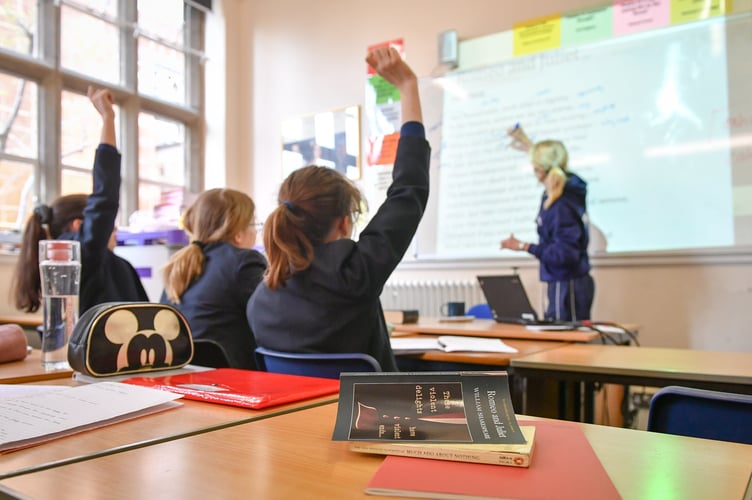As pupils return to schools for the new academic year, we look at the impact of the coronavirus pandemic on children in North Somerset and across England.
The first story of this three-part series looked at children in poverty. This is the second piece, which investigates the state of children's education.
Pupil attendance
The rate of pupils persistently missing school across the country has increased significantly following the coronavirus pandemic.
In the 2019-20 autumn term, 13.1% of pupils missed at least 10% of school sessions. Last year, this jumped to 19.5%, a near-50% rise in the number of children persistently absent.
Meanwhile, the proportion of children missing at least half of school sessions has more than doubled, from 0.9% to 2%.
The figures led the Education Secretary to label high truancy rates an "epidemic".
Bridget Phillipson, writing in the Sunday Times, warned she will make no "apologies" for fining parents with frequently absent children, and added too many parents allow children time off for holidays, birthdays or a "runny nose".
In North Somerset, persistent absence rates have jumped from 13.1% in the 2019 autumn term to 20.5% last year.
The proportion of pupils missing at least half of classes has also risen significantly, with 2.1% of children in North Somerset missing 50% or more of their school sessions last autumn.
James Bowen, assistant general secretary at school leaders' union NAHT, said attendance has declined significantly since the pandemic, fuelled by factors including rising anxiety and poor mental health, poverty, challenges at home, and under-resourced support for children with special educational needs.
Mr Bowen said: "It’s vital children attend school whenever possible – pupils can easily miss crucial steps in their learning if they’re absent."
Pupil behaviour
Nationally, suspension rates have also risen since the before pandemic – including in North Somerset.
In North Somerset, 8.6 suspensions per 100 pupils were handed out in the 2022-23 academic year.
This was up from six per 100 in 2018-19.
Across the country, suspension rates more than doubled, from 3.8 per 100 pupils in 2018-19 to 9.3 per 100 last year.
The Institute for Public Policy Research think tank and education charity The Difference estimate suspensions and exclusions rose by more than 20% in the 2023-24 Easter term compared with the same period the year before.
Kiran Gill, IPPR associate fellow and chief executive of The Difference, said: "The past four years, post-pandemic, have seen an alarming rise in children losing learning.
"We should all be worried about the social injustice that the most marginalised children – who already have the biggest barriers to opportunity outside of school – are those most likely to be not in classrooms through absence, suspension and exclusion."
The Department for Education said the rising number of school suspensions is "shocking".
A spokesperson said: "We are determined to get to grips with the causes of poor behaviour; we’ve already committed to providing access to specialist mental health professionals in every school, introducing free breakfast clubs in every primary school, and ensuring earlier intervention in mainstream schools for pupils with special needs.
"But we know poor behaviour can also be rooted in wider issues, which is why the Government is developing an ambitious strategy to reduce child poverty led by a taskforce co-chaired by the Education Secretary so that we can break down the barriers to opportunity."
Attainment and development
The pandemic has also harmed young children's speech, reading and writing skills. In Year Two, 89% of pupils in England met the expected standard in their phonics assessment, which assesses their speaking, reading and pronunciation – down from 91% in 2018-19.
Only seven areas saw a rise in children's phonics skills following the pandemic. Some 89% of Year Two children met the expected phonics standard in North Somerset, down from 93% in 2018-19.
Meanwhile, children's attainment in Key Stage Two has also worsened, with just 60% of pupils reaching the expected standard in reading, writing and maths in 2022-23 – down from 65% in 2018-19.
North Somerset also saw a decrease, with the proportion of children performing to the expected level falling from 65% to 60%.
Paul Whiteman, general secretary of the NAHT, said: "The Government clearly hasn’t done nearly enough to support children’s recovery from the pandemic, and it is depressing that this has further harmed those children who need help the most."
A DfE spokesperson said: "We want to make sure that children from all over the country, regardless of background, have the same opportunities to succeed and attain the highest levels.
"We have made almost £5 billion available since 2020 for education recovery initiatives, including high quality tutoring for the children who need the most support.
"We are also supporting disadvantaged pupils through the pupil premium, which is rising to almost £2.9 billion in 2024-25, the highest in cash terms since this funding began."




